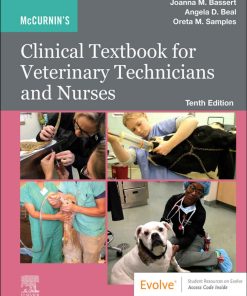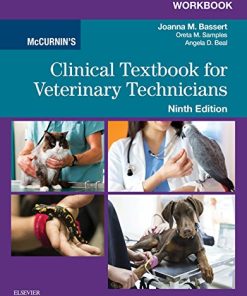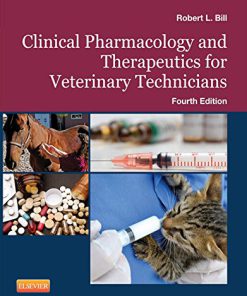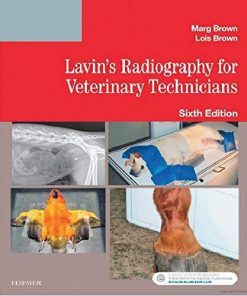Workbook for McCurnin’s Clinical Textbook for Veterinary Technicians and Nurses 10th Edition by Joanna Bassert, Angela Beal, Oreta Samples 0323722018 9780323722018
$50.00 Original price was: $50.00.$25.00Current price is: $25.00.
Workbook for McCurnin’s Clinical Textbook for Veterinary Technicians and Nurses 10th Edition by Joanna M. Bassert, Angela D. Beal, Oreta M. Samples – Ebook PDF Instant Download/DeliveryISBN: 0323722018, 9780323722018
Full download Workbook for McCurnin’s Clinical Textbook for Veterinary Technicians and Nurses 10th Edition after payment.
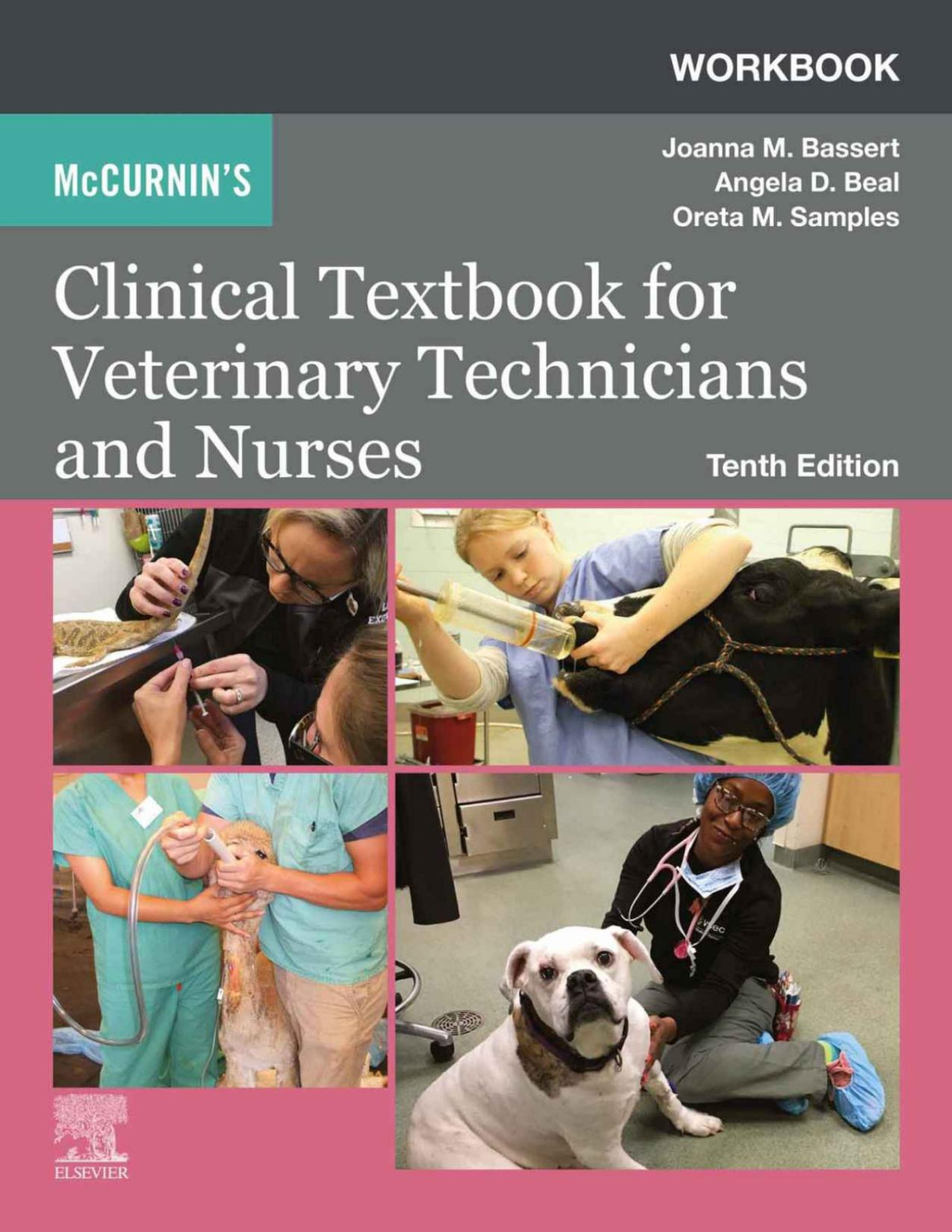
Product details:
ISBN-10 : 0323722018
ISBN-13 : 9780323722018
Author: Joanna M. Bassert, Angela D. Beal, Oreta M. Samples
Master all the animal care duties of a veterinary technician! McCurnin’s Clinical Textbook for Veterinary Technicians and Nurses, 10th Edition provides a solid foundation in every aspect of veterinary technology, including care of small and large animals, birds, reptiles, and small mammals. Procedure boxes offer step-by-step guidelines to performing key tasks, and use of the veterinary technician practice model helps to improve your critical thinking and decision-making skills. Written by vet tech experts Joanna Bassert, Angela Beal, and Oreta Samples, this illustrated guide prepares you for success on the Veterinary Technician National Exam (VTNE®) and in clinical practice.
Workbook for McCurnin’s Clinical Textbook for Veterinary Technicians and Nurses 10th Table of contents:
Part 1. Veterinary Technology: An Overview
1. Introduction to Veterinary Nursing and Technology: Its Laws and Ethics
Introduction
Veterinary Technician Oath
History of Veterinary Technology
The Veterinary Nurse and Technician Today
Education
The Veterinary Technician National Examination (VTNE)
The Profession of Veterinary Technology and Veterinary Nursing
Terminology and the Veterinary Health Care Team
Professionalism
Professional Organizations and Acronyms
Professional Ethics
Profession-Related Laws and Regulations
Additional Laws Governing Veterinary Practice
2. Veterinary Practice Management
Introduction
Types of Veterinary Practices
Typical Employee Positions
Practice Facilities and Workflow
Clients and Client Services
Management of the Veterinary Practice
Summary
3. Veterinary Medical Records
Introduction
Principles and Functions of the Medical Record
Medical and Legal Requirements
Format of Veterinary Medical Records
Components of the Problem-Oriented Veterinary Medical Record
Management of Electronic Medical Records
Management of Paper Medical Records
Management of Ambulatory Practice Records
4. Occupational Health and Safety in Veterinary Hospitals
Introduction
Safety
General Workplace Hazards
Medical and Animal-Related Hazards
A Dirty Mouth? Precautions for Dentistry Operations
Radiology
Anesthesia
Compressed Gases
Sharps and Medical Waste
Hazardous Drugs and Pharmacy Operations
Part 2. Patient Management and Nutrition
5. Animal Behavior
Introduction to Behavior and Motivation
The Roles of Professionals in Behavior
How Animals Learn
Behavior Modification
Animal Development
Meeting the Needs of Animals
Common Unwanted Behaviors, Active Prevention, and Intervention
Common Unwanted Behaviors of Dogs and Cats
Common Equine Behavior Concerns
Common Cattle Behavior Concerns
Small Ruminant Behavior Concern
Behavior Emergencies
Learning in the Veterinary Setting
Fear FreeTM Fundamentals
Happy Visits and Victory Visits
Behavior and the Emotional Medical Record
6. Restraint and Handling of Animals
Introduction
Minimizing Stress
Animal Stabilization and Restraint
Introduction to Equine Restraint
An Introduction to Herd Animals
Capture and Restraint of Cattle
Capture and Restraint of Swine
Capture and Restraint of Small Ruminants
Capture and Restraint of Avian and Exotic Species
Restraint of Small Mammals
Restraint of Reptiles
7. History and Physical Examination
Introduction
History and Physical Examination of Small Animals
History and Physical Examination of Large Animals
8. Preventive Health Programs
Introduction
Preventive Health Programs for Dogs and Cats
Preventive Health Program for Horses
Preventive Health Programs for Livestock Species
Summary
9. Animal Nutrition
Introduction
Basics of Nutrition
Nutritional Evaluation of Small Animals
Cats and Nutrition
Feeding Pets
Life Stage Nutrition for Cats and Dogs
Feeding Horses and Other Livestock
Nutrition for Birds and Small Mammals
10. Animal Reproduction
Introduction
Overview of Female Reproduction
Overview of Male Reproduction
Canine Reproduction
Feline Reproduction
Equine Reproduction
Bovine Reproduction
Ovicaprine (Sheep and Goats) Reproduction
Camelid Reproduction
Breeding Soundness Examination of the Male
Breeding Soundness Examination of the Female
Summary of Some Interesting Recent and Emerging Advances in Reproduction Biotechnology
Part 3. Clinical Sciences
11. Hematology and Cytology
Introduction
Hematology
Coagulation Testing
Cytology
12. Clinical Chemistry, Serology, and Urinalysis
Introduction
Clinical Chemistry
Serology
Urinalysis
13. Parasitology
Introduction
Parasitic Diseases of Large and Small Animal Species
Diagnosis of Ectoparasites
Diagnosis of Endoparasites
Ectoparasites of Veterinary Importance
Endoparasites of Veterinary Importance
Protozoans of Zoonotic Importance
14. Clinical Microbiology
Introduction
Microbiological Safety
Sample Collection and Preservation
Direct Examination of Microbial Specimens
Staining Procedures
Bacterial Culture and Identification
Methods of Antimicrobial Susceptibility Testing
Fungal Culture (Mycology)
Virology
Molecular Detection of Pathogens
Nosocomial Infections
15. Diagnostic Imaging
Introduction
Radiology
Ultrasonography
Alternative Imaging Modalities
16. Basic Necropsy Procedures
Introduction
Necropsy
Necropsy Reports
Sample Collection for Laboratory Testing
Shipping Diagnostic Specimens
Facilities and Instruments
Necropsy Procedure for a Small Mammal
Necropsy Variations
Part 4. Medical Nursing
17. Diagnostic Sampling and Therapeutic Techniques
Introduction
Sampling Techniques in the Small Animal
Administration of Medication in the Small Animal
Administration of Medication in the Large Animal
Sampling Techniques in the Large Animal
18. Small Animal Medical Nursing
Introduction
A Veterinary Technician Practice Model: The Nursing Process
Small Animal Diseases
19. Large Animal Medical Nursing
Summary
Introduction
Equine Nursing
Common Diseases and Conditions of Horses
Care of the Hospitalized Equine Patient
Common Diseases and Conditions of Ruminants
Common Diseases and Conditions of Swine
Common Diseases and Conditions of Camelids
20. Veterinary Oncology
Introduction
Pathogenesis of Cancer
Epidemiology of Cancer
Clinical Signs
Diagnostics
Staging
Therapeutic Options
Cancer in Horses
Cancer in Cattle
21. Neonatal Care of Puppies, Kittens, and Foals
Introduction
Neonatology of Puppies and Kittens
Neonatology of Foals
Summary
22. Care of Birds, Reptiles, and Small Mammals
Introduction
Birds
Reptiles
Small Mammals
23. Rehabilitation and Alternative Medical Nursing
Introduction
Nutraceuticals and Chondroprotectants
Herbal Medicine
Acupuncture
Veterinary Spinal Manipulative Therapy
Rehabilitation Therapy
Summary
Part 5. Emergency and Critical Care
24. Fluid Therapy and Transfusion Medicine
Introduction
Fluid Therapy
Transfusion Medicine
25. Emergency and Critical Care Nursing
Introduction
Emergency and Critical Care Nursing: Small Animal
Canine and Feline Electrocardiography
Emergency and Critical Care Nursing: Equine
Emergency and Critical Care Nursing: Food Animal
26. Toxicology
Introduction
Managing Poison Emergencies
Decontamination
Supportive Care
Household Hazards
Dangerous Plants
Pesticides
Antifreeze Products
Human Medications
Drugs of Abuse
27. Wound Management and Bandaging
Wound Healing
Small Animal Wound Management
Large Animal Wound Management
Part 6. Anesthesia, Analgesia, and Pharmacology
28. Pharmacology and Pharmacy
Introduction
Types of Drugs
Drug Administration
Dosage Terminology
Basic Pharmacokinetics
Basic Pharmacodynamics
Impact of Disease on Drug Pharmacokinetics
Aging and Drug Pharmacokinetics
Drug Nomenclature
Systemic Approach to Drug Classification
Regulatory Pharmacology
The Veterinary Pharmacy
Prescribing and Dispensing Drugs
29. Pain Management
Introduction
The Role of the Veterinary Technician as a Patient Advocate
The Science of Pain Management
Treatment of Pain in Small Animals
Treatment of Pain in Large Animals
Species-Specific Information
Summary
30. Veterinary Anesthesia
Inhalant Anesthetics
Introduction
What Is Anesthesia?
Patient Preparation
Anesthetic Agents
Anesthesia Equipment
Principles of Endotracheal Intubation
Monitoring the Anesthetized Patient
Small Animal Anesthesia
Equine Anesthesia
Ruminant Anesthesia
Manual and Mechanical Ventilation
Anesthetic Problems and Emergencies
Part 7. Surgical Nursing
31. Surgical Instruments and Aseptic Technique
Introduction
Instrumentation
Aseptic Technique
32. Surgical Assistance and Suture Material
Introduction
General Concepts in Veterinary Surgical Assisting
Preoperative Preparation
Intraoperative Techniques and Duties
Suture Material
Postoperative Management
Surgical Assisting for Equine Patients
33. Small Animal Surgical Nursing
Introduction
Preoperative Patient Assessment
Surgical Preparation and Animal Positioning
Common Surgical Procedures
Elective Versus Nonelective Surgery
Tail Docking and Dewclaw Removal in Puppies
Tail Docking and Dewclaw Removal in the Adult Dog
Feline Onychectomy
Celiotomy
Gastrointestinal Surgery
Gastric Dilatation–Volvulus
Ovariohysterectomy in Dogs and Cats
Pyometra
Canine Castration
Feline Castration
Cesarean Delivery
Cystotomy
Urethrostomy
Hernias
Lumpectomy
Removal of Mammary Neoplasia
Amputation
Care of the Neurologic Patient
Orthopedic Surgery
Client Education
Guidelines for Discharge Instructions
34. Large Animal Surgical Nursing
Introduction
Surgical Nursing of Horses
Surgical Considerations
35. Veterinary Dentistry
Introduction
Ethical and Legal Aspects
Dental Morphology
Oral Examination and History
Dental Radiography
Periodontal Disease
Periodontal Debridement
Power Scaling
Hand Scaling
Polishing
Regional Nerve Blocks for Oral Surgery in Dogs and Cats
Periodontal Surgery
Home Care
Exodontics
Advanced Dental Procedures
Specific Conditions in Dogs and Cats
Equine Dentistry
Part 8. End of Life
36. Geriatric and Hospice Care: Supporting the Aged and Dying Patient
Geriatric Dogs and Cats
The Aging Process
When Are Dogs and Cats Considered to Be Senior or Geriatric?
Physiologic Changes Associated With Aging
Effects of Aging on Organ Systems
Cognitive Impairment and Other Behavioral Issues
Management Strategies to Improve Quality of Life
Hospice and Palliative Care
Companion Animal Death and Dying
Geriatric Horses
Physical Examination
Common Problems in Aging Horses
Chronic Diseases of the Geriatric Horse
Management, Nutrition, and Nursing Care of the Geriatric Horse
End-of-Life Issues
37. The Human–Animal Bond and Euthanasia
Introduction: The Human–Animal Bond
Bond-Centered Care
The Veterinary Technician’s Roles in End-of-Life Cases
Decisions: Goals of Care, Euthanasia, and Natural Death
Euthanasia: The Art of Providing a Good Death
Hospice-Supported Natural Death
Aftercare and Memorialization
The Grieving Human and the Grieving Animal: When the Bond Changes
The Critical Need for Self-Care
Summary: Key Points for This Chapter
People also search for Workbook for McCurnin’s Clinical Textbook for Veterinary Technicians and Nurses 10th:
pain management for veterinary technicians and nurses
canine and feline behavior for veterinary technicians and nurses
nutrition and disease management for veterinary technicians and nurses
anesthesia and analgesia for veterinary technicians and nurses
physical rehabilitation for veterinary technicians and nurses
Tags: Workbook, McCurnin, Clinical Textbook, Veterinary Technicians, Nurses, Joanna Bassert, Angela Beal, Oreta Samples
You may also like…
Uncategorized
Workbook for McCurnin’s Clinical Textbook for Veterinary Technicians E Book 9th Edition, (Ebook PDF)
Uncategorized
Clinical Pharmacology and Therapeutics for Veterinary Technicians E Book 4th Edition, (Ebook PDF)
Arts - Graphic Arts
Romance - Contemporary Romance
Jock Seeks Geek: The Holidates Series Book #26 Jill Brashear
Uncategorized




